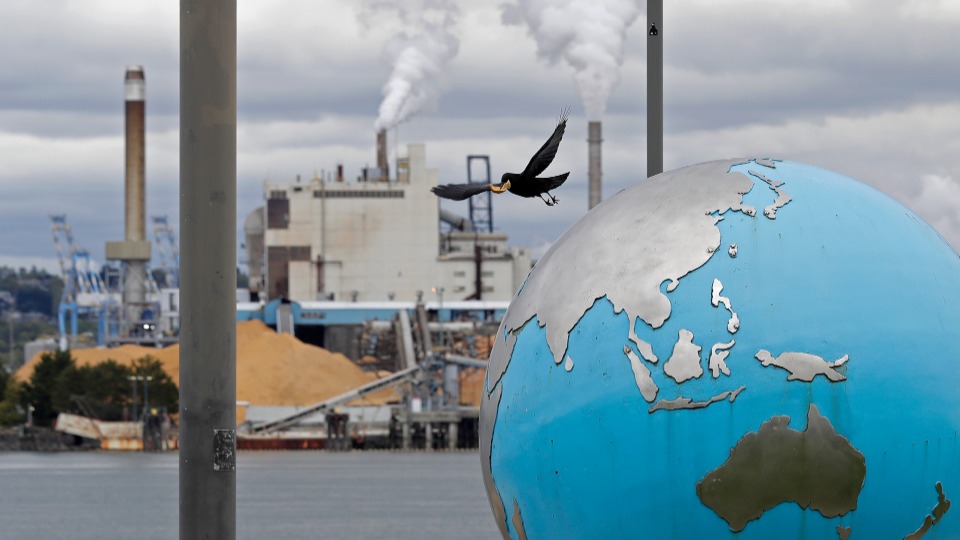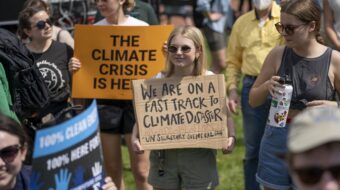
President Joe Biden announced an ambitious goal to reduce U.S. greenhouse gas emissions (GHG) in response to the looming climate crisis on Thursday morning. With the goal, GHG emissions are to be reduced by 50% of the 2005 level by the year 2030. Getting to the goal would entail a fundamental transformation in U.S. society in energy production, conversion to electric vehicles, energy efficiency in homes and offices, and a massive expansion and protection of forests, coastal areas, and ecological systems.
The goal, also known as the Nationally Determined Contribution (NDC) under the Paris Climate Accords, was announced at the Leaders Summit on Climate on Earth Day (April 22-23) called by the Biden administration. Environmentalists, scientists, labor leaders, and many elected officials and businesses enthusiastically greeted the announcement, which requires an all-government and national mobilization to achieve.
The world sits on the precipice of climate catastrophe. The World Meteorological Organization (WMO) released a study showing the average temperature has risen 1.2 degrees Celsius over pre-industrial levels, dangerously close to the tipping point of 1.5 degrees Celsius that many scientists think is the point of no return. “We are on the verge of the abyss,” United Nations Secretary-General António Guterres said at a press conference announcing the findings earlier this week.
The WMO finding is the latest sign illustrating the gravity of the climate crisis and the need for the global community to act urgently and now. With that background, the 40 leaders of the world’s major economies, nations at the frontlines of the climate crisis, and scientists participating in the virtual Leaders Summit will share national plans, new technologies, and experiences to mitigate GHG. The U.S. goal ups the ante for global action in the run-up to the U.N. Climate Change Conference of Parties (COP26) in Glasgow, Scotland, in November.

If met, the NDC commitments by the global community will reduce emissions to keep the Earth’s temperatures below the 1.5-degree Celsius increase. Going above that means almost inevitable environmental catastrophe. Scientists are warning the present national commitments are not enough to meet the Paris Agreement goal, so the Biden administration’s announcement was welcomed.
“Many would argue this is not possible. But I would argue there are many opportunities to be very aggressive,” said Biden’s chief climate advisor, Gina McCarthy. “It’s a massive investment in people and recognition that climate change is about human beings.” McCarthy was EPA administrator in the Obama administration, then directed the National Resources Defense Council, a leading environmental organization.
White House Special Climate Envoy John Kerry met with his counterpart in China last week. The two countries issued a statement expressing the hope that this week’s Leader’s Summit would give fresh impetus to global efforts to reduce GHG emissions. “(We) share the summit’s goal of raising global climate ambition on mitigation, adaptation, and support on the road to COP26 in Glasgow,” said the joint statement.
Together, the U.S. and China emit 42% of global GHG, so their leadership and stepped up action is essential. The U.S. is the leading emitter of GHG emissions per capita, accounting for roughly 14% of all global emissions. China is the other top emitter, at 28%, though on a per capita basis its emissions are still far lower than the U.S. At the U.N. Climate Ambition Summit in December, President Xi Jinping announced China would be carbon neutral before 2060, achieve peak emissions by 2030, expand renewable energy and reforestation, and called for a green economic recovery post-pandemic.
“You know I hear a lot of people signing on to 2050 net zero and so forth. It is welcome. It is critical,” Kerry told the Washington Post. “But it’s 30 years from now. And if we don’t have people signing on what they’re going to do to raise ambition between 2020 and 2030, we don’t get where we need to go in 2050 and there is no holding the Earth’s temperature increase to the 1.5 degrees Celsius, which is the standard now that we’re working on.”
Biden and the Democratic-controlled Congress are making climate policy central to governing after four years of the disastrous anti-climate policies of the Trump administration. They see climate action as a tool for job creation at union wages, a racial justice measure, a health priority, and a foreign policy issue. Besides McCarthy and Kerry, the administration assembled a solid environmental and climate leadership team when taking over from Trump.
But precisely because of the back-and-forth from ambitious pro-climate goals to environmental sabotage from one presidential administration to the next, the world remains skeptical of the U.S. when it comes to meaningful climate action. Near the end of the Obama administration, the U.S. was a key mover in crafting the Paris Climate Accords, only to see a complete withdrawal from them under Trump. Biden now inherits the challenge of convincing the rest of the world that the U.S. will be in it for the long haul this time.
Achieving the ambitious goal he set on Thursday will require detailed legislation and a strategy to get it through Congress and overcome Republican filibuster threats. So far, a National Climate Plan outlining the steps needed to halve emissions has yet to be issued. But the White House says many elements are already present in the administration’s approach, which environmental organizations and scientists have been instrumental in shaping.

The Biden administration policies, if fulfilled, would make the energy sector carbon-neutral by 2035 and the economy completely carbon neutral by 2050. But the policies also adapt the U.S. to climate change by rebuilding the nation’s infrastructure, dealing with sea-level rise, droughts, and extreme weather events. According to the approach, the entire government is mobilizing in a strategic, integrated way.
In the first 100 days, Biden issued executive orders to restore the role of science, rejoin the Paris Climate Agreement, centered climate as a social justice and national security issue, and repealed scores of Trump’s anti-climate regulations.
Another executive order commits the U.S. to conserve 30% of the country’s land and coasts by 2030, known as 30 by 30, to bolster resiliency to sea rise and enhance the role forests, agriculture, and grasslands play in carbon sequestration. Biden also called for establishing a Civilian Climate Corps to employ young people on resilience and restoration projects.
Biden’s most significant policy is the popular $2.3 trillion American Jobs Plan (AJP), which many call his climate plan. Though the plan is winning wide praise for many of its ambitious goals, its expenditures for climate action are not as large as many environmental activists had hoped. But if passed over GOP obstruction, the AJP will move the U.S. economy a giant step toward clean energy while enhancing GHG mitigation.
The AJP has eight central climate planks that meld job creation and racial justice. The plan will spend $650 billion on clean energy transition and $215 billion to build, modernize, and weatherize affordable housing. It budgets $174 billion to transition to electric vehicles by building 500,000 electric charging stations and using government procurement to transition to an all-electric federal vehicle fleet. The bill allocates $100 billion for power grid modernization and invests $85 billion in public transit.
Biden is riding the rapidly growing momentum for action, backed by overwhelming majority public support. In the absence of federal leadership under Trump, much of the action was with state and local governments still committed to the Paris Agreement.
In Congress, progressive lawmakers are also on the move with climate action proposals. Rep. Alexandria Ocasio-Cortez, D-N.Y., and Sen. Ed Markey, D-Mass., re-introduced a resolution backing the Green New Deal on Tuesday ahead of the summit. Their proposal calls for meeting the country’s energy needs through zero-emission sources and transforming the transportation sector to remove pollution through investing in zero-emission vehicles, public transit, and high-speed rail.
“For so long, our movement towards a sustainable future has been divided with really just this false notion that we have to choose between our planet and our economy,” Ocasio-Cortez said during a press conference. “We decided to come together in sweeping legislation that not only rejects that notion, but creates a plan for 20 million union jobs in the United States of America, to rebuild our infrastructure, to restore public housing, to make sure that we expand our access not only to EV (electric vehicle) and EV infrastructure but mass transit,” she added.
Over 1,500 scientists sent an open letter to Biden laying out multiple paths they say the administration can take to reach a 50% reduction in GHG emissions. While converting to clean energy is the core of the plan, mitigation efforts through building up “carbon sinks” by expanding forests and making changes in agriculture are also essential. The Biden administration adopted many of their proposals.
“Hundreds of scientists have affirmed that the ambitious goal of cutting emissions in half by 2030 is scientifically feasible and the minimum threshold for what’s necessary,” said Dr. Rachel Cleetus, policy director and lead economist in the Climate and Energy Program at the Union of Concerned Scientists. “We know that we will need to ratchet up ambition even further in the years to come to help limit the worst impacts of climate change and achieve the principal goal of the Paris Agreement—limiting warming to as close to 1.5 degrees Celsius as possible.”












Comments